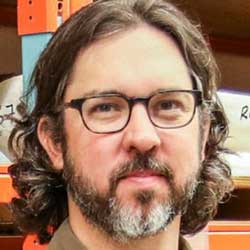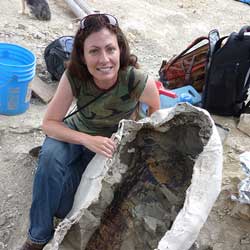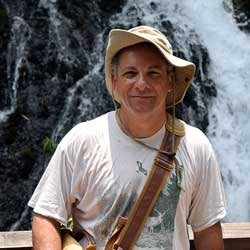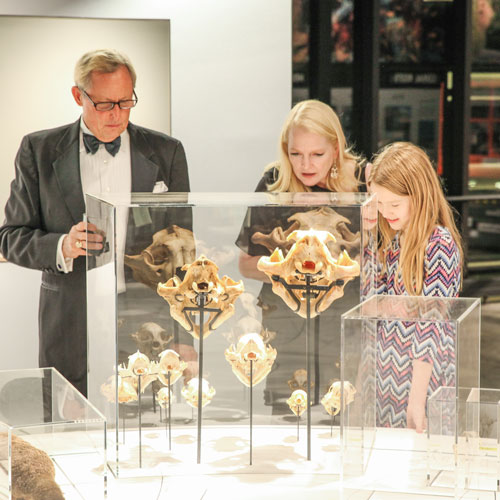Dino Lecture: The Last of the Dinosaurs
Date & Time
Thursday, June 16, 2022
5:30–7 PM
This event is in the past.
Tickets
FREE & open to all.
Registration is required.
Donations are appreciated
& support the work of the museum.
Location
VIRTUAL EVENT
Join us from your home!
What happened to life on Earth during the Cretaceous, the end of the Age of Dinosaurs?
During this talk, three paleontologists will dig into the remarkable research about the last 10 million years of the dinosaur world in North America.*
*Except for birds.
Burke members receive a month of access to our Paleontology Virtual Field Trip. Not a member? Join today!
Event Topics
 Dr. David C. Evans, Senior Curator of Vertebrate Paleontology, Royal Ontario Museum
Dr. David C. Evans, Senior Curator of Vertebrate Paleontology, Royal Ontario Museum
“Diagnosing Cancer in a Horned Dinosaur”
In 2020, my team announced the discovery and diagnosis of cancer in a dinosaur for the first time. The aggressive cancer was discovered in a fibula (leg bone) belonged to the horned dinosaur Centrosaurus apertus that lived ~76 million years ago in Alberta, and provided insights into the antiquity and evolution of this rare type of cancer, as well as insights into dinosaur sociobiology. To make this extraordinary diagnosis, it took a large team of multidisciplinary specialists and medical professionals from fields, and in doing so set a new standard for paleopathological research.
 Dr. Holly N. Woodward, Associate Professor of Anatomy and Paleontology, Oklahoma State University Center for Health Sciences
Dr. Holly N. Woodward, Associate Professor of Anatomy and Paleontology, Oklahoma State University Center for Health Sciences
“Putting Tyrannosaurus rex Under the Microscope: What bone histology is revealing about the Tyrant King”
Most of what we know about Tyrannosaurus rex growth and behavior comes from studying the shape of its bones, but a completely different kind of growth record is preserved inside them. See how the stories told by microscopic features within the bones of the Tyrant King teach us even more about the world’s most iconic dinosaur.
 Dr. Peter D. Roopnarine, Curator of Geology, California Academy of Sciences
Dr. Peter D. Roopnarine, Curator of Geology, California Academy of Sciences
“The Darkest Day: The day the sun set on the dinosaurs”
The asteroid that collided with the Earth 66 million years ago blotted out sunlight for at least two years. Our work is exploring how the rich dinosaur-dominated ecosystems of the day responded, and the contribution of darkness to the extinctions.
About the Speakers
Dr. David C. Evans holds the Temerty Chair in Vertebrate Palaeontology and oversees dinosaur research at the Royal Ontario Museum (ROM). He is also an Associate Professor in the Department of Ecology and Evolutionary Biology at the University of Toronto. David is an Ontario-born researcher who is recognized globally as an authority on the rich dinosaur fossil record of Canada, and on the mass extinction event that marked the end of the Age of Dinosaurs. As a curator, David helped develop the ROM's dinosaur galleries, and was Lead Curator of the major travelling exhibition Ultimate Dinosaurs. He has been featured on numerous television shows, and most recently, David was co-creator of the HISTORY series Dino Hunt Canada. David’s research focuses on the evolution, ecology and diversity of dinosaurs, and their relationship to environmental changes leading up to the end Cretaceous mass extinction event. Active in the field, he has participated in expeditions all over the world, including the Africa, Mongolia, and Canada, and has helped discover 10 new dinosaur species in the last five years—including the remarkable horned dinosaur Wendiceratops from southern Alberta, and the wickedly armoured Zuul named after the Ghostbusters movie monster.
Dr. Holly N. Woodward uses large-sample osteohistology to assess growth dynamics, individual variability, and survivorship in dinosaurs and other extinct vertebrates. To validate such life history interpretations, she correlates biological signals in the bone tissue microstructure of extant vertebrates for which an individual life history record is documented. In addition to bone microstructure interpretative validation, such documentation in extant vertebrates permits separation and quantification of variation in growth, behavioral, and physiological signals, so that these factors can be considered in an empirical context when interpreting fossil bone microstructure.
Dr. Peter D. Roopnarine
I am the Curator of Geology, and I've been at the Academy since 1999. I hold degrees in Biology (B.Sc.), Oceanography (M.S.) and Geology (Ph.D.). My research is transdisciplinary, with a focus on understanding the evolution of ecological systems, emphasizing paleontology, deep time, and perspectives on complexity dynamics. Most of my research these days centers around global change biology, and how we can further develop our understanding of Earth's past ecosystems to better forecast our future.
I was born in the United Kingdom, and grew up in the beautiful countries of Jamaica, and Trinidad & Tobago. I earned my Ph.D. from the University of California Davis, and later became a citizen of the United States. I am a strong supporter of immigrants, broad inclusivity of all persons in American society, and the promotion of groups underrepresented and marginalized in the sciences, particularly on the bases of ethnicity and gender identity.
Dr. Gabriela Chavarria serves as the Executive Director of the Burke Museum of Natural History and Culture. In this role, Dr. Chavarria carries forward the Burke's mission to care for and share natural and cultural collections so all people can learn, be inspired, generate knowledge, feel joy, and heal.
Prior to the Burke, she served as the VP and Chief Curator, Science Division, at the Denver Museum of Nature & Science. Previously, she was senior science advisor and forensic science branch chief at the U.S. Fish and Wildlife National Forensics Laboratory. Dr. Chavarria received her bachelor’s degree in biology from the National Autonomous University of Mexico, and her master’s and Ph.D. in organismic and evolutionary biology from Harvard University.
Growing up in Mexico City, Dr. Chavarria developed a passion for nature and science at an early age, especially for bees. She has devoted her career to the conservation of native pollinators, especially bumble bees. Her recent work as a wood anatomist focused on fighting the illegal trafficking of tropical hardwoods. Dr. Chavarria has conducted research in more than 30 countries throughout the world and sits on numerous boards and advisory councils, including the American Institute of Biological Sciences, the National Parks Conservation Association, Defenders of Wildlife, The Nature Conservancy of Colorado, and the Doris Duke Conservation Scholars at the University of California, Santa Cruz.
Dr. Gregory Wilson Mantilla is the Director of the DIG Field School and is a Professor in the Department of Biology, Curator of Vertebrate Paleontology at the Burke Museum, and an Adjunct Professor in the Department of Earth and Space Sciences at the University of Washington. He is also a Research Associate at the University of California Museum of Paleontology and was a Curator of Vertebrate Paleontology at the Denver Museum of Nature & Science. He has been published in a number of prestigious scientific journals including Nature, Science, Geological Society of America Special Papers, Paleobiology, Journal of Vertebrate Paleontology, and Scientific Reports and has appeared in on-line reporting for the Huffington Post for his work in Hell Creek, Montana as well as Nature Podcasts and Science Daily. His research has been funded by a number of organizations including the National Geographic Society, NSF, USDA Forest Service, the American Philosophical Society, and the Paleontological Society.
Greg attended Stanford University as an undergraduate and received his PhD in Integrative Biology from the University of California, Berkeley in 2004 and was an NSF Postdoctoral Fellow at the University of Helsinki in 2005.
This event is sponsored by Nathan Myhrvold and Rosemarie Havranek.

